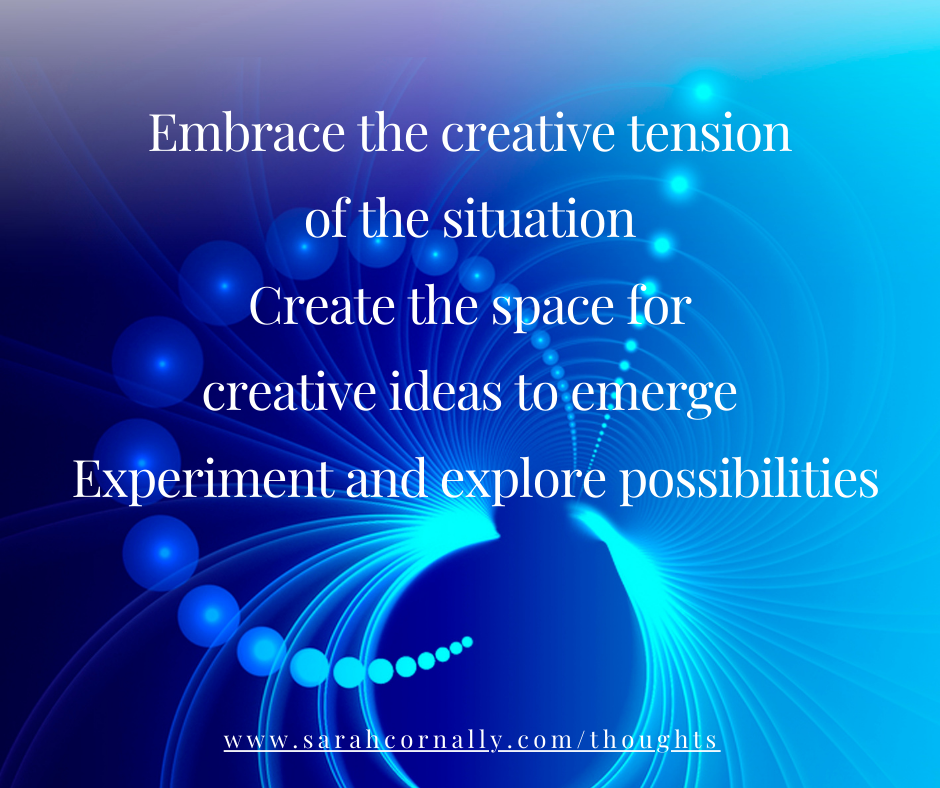
The opportunity to respond creatively to the challenges of returning to the new normal
As we move out of Covid there will be a number of experiences which may feel alien and unsafe. This might activate a tendency to move into a self-preserving or reactive mindset which seeks out what’s safe and secure.
Some people are returning to the office – having missed connection and wanting community – but are instead finding that, because there are so many rules and protocols, that they’d rather work at home after all. What used to be a place which felt warm and friendly and connected, now is not. Some people may feel safer at home than at work from a health perspective – successful isolation can mean many people now find it difficult to trust that they won’t be exposed to Covid in the workplace, despite all the protocols. That may be in their awareness, perhaps only subtly and not even in their awareness, and active just the same.
Leaders might wonder what they can do about that. On a practical level they can’t do much to change this new reality – the rules and protocols are a legal requirement and we are in a phase where all of those things are required. With this, as with so many other experiences, it’s not about good or bad, or right or wrong, rather what are we learning? Everything to do with Covid appears to be forcing us to adapt and evolve and it’s creating tensions. How can those tensions be worked with rather then removed? This converts them into creative tensions.
This kind of mindset is really important – at all times of course – but particularly in the Covid context because we are going to come up against things which aren’t going to make it easy so the important question is how do we work with it so it’s developmental instead of anything other than that?
At this point, what is useful is for leaders to be mindful of the possible anxiety and fear around returning to the workplace. Be aware that yes, the conditions that people are coming back to are going to feel different. Therefore, your pre-planned approaches and logical ways of responding in order to operate in the future will need to be nuanced to find what works.
One important way of doing that is to allow and enable spaces where people can show up, share and speak openly about what is present for them. This can help people to move through the issues more quickly. So instead of people going back to working from home in contracted ways there’s some hybrid or some version of a way forward for groups of people to respond to their future state.
Is there a momentum from your team to move forward to the future state or is everyone feeling the difficulty, constraints and resistance due to all the disruption? The teams that are allowing the space for people to communicate regularly or if they are able to respond in real time. It’s about increasing emotional proximity.
Encouraging a quick and safe return is an important impetus on leaders right now. People may be saying they don’t want to go into the office because it doesn’t feel the way they want it to feel so there is a very real problem of large swathes of the working population contracting back to ‘safety’ – to what is now their new normal – of working from home. Indeed, one company surveyed their employees to determine who would want to work from home going forward and found that 80% said they would rather continue to work at home (having thought around 60% would want to).
Taken at face value this would require the company to radically alter its way of operating. However, will people want to continue to work from home over time? At the moment it is new to work at home – people had to – they may not have wanted to, but for many it was better than they thought. However, an important question is what will happen to their sense of community over time? There may well be a blush of newness to all this. What will happen when this novel situation it starts to have the mundaneness of the ordinary?
Companies could end up making some very big decisions – such as changing the footprint of their offices – based on inadequate experience. Views may well shift in six months’ time. These sort of things needs to be considered from several perspectives. Now, more than ever, leaders need to hasten slowly – to sit in the discomfort of not knowing all the answers and allowing them to be revealed over time; managing people’s discomfort and experimenting as new ways forward are discovered.
Leaders who have the capacity to respond to the emergent challenges of the future will realise leveraged results. My work with senior leaders helps them to sit with paradox, be open to multiple perspectives, anticipate unintended consequences, and make decisions that are more elegant and healthier for the whole system both commercially and culturally. Please reach out if I can be of any assistance at this time – Sarah Cornally – Strategic Leadership Advisor, Cornally Enterprises Pty Ltd, +61 2 9801 0659 or info@sarahcornally.com







